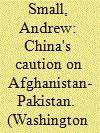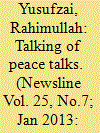| Srl | Item |
| 1 |
ID:
097100


|
|
|
|
|
| Publication |
2010.
|
| Summary/Abstract |
The ongoing crisis in Afghanistan and Pakistan looks like a prime candidate for closer cooperation between the United States and China. There are various broadly shared interests in combating terrorism, containing rising extremism, and supporting the stability of both states. With its extensive influence in Pakistan and substantial economic capacity, Beijing has important assets to bring to the table. In practice, however, efforts to achieve convergence have proved frustrating. Differences run deep over how to address the extremist threat and the broader geopolitics of the region. And as is true of its foreign policy elsewhere, China pursues a relatively narrow conception of its interests in Afghanistan and Pakistan, rather than supporting a more widely shared set of goals.
|
|
|
|
|
|
|
|
|
|
|
|
|
|
|
|
| 2 |
ID:
118651


|
|
|
| 3 |
ID:
192236


|
|
|
|
|
| Summary/Abstract |
How can we understand the resurgence of Tehrik-i-Taliban Pakistan (TTP) in the former Federally Administered Tribal Areas (FATA)? Framing FATA as a Zomian space, we argue that its “friction of terrain” provided nonstate spaces for the emergence as well as the resurgence of TTP. The literature describes TTP as an outcome of global political and security compulsions, Islamabad’s regional policies, and ideological associations with the Afghan Taliban. The present study adds terrain to the discussion. Islamabad, after militarily destroying TTP, announced the FATA merger in 2018. However, TTP’s revival not only problematizes the state’s role but also affirms the continuation of Zomian character: the nonstate spaces that facilitated TTP’s ability to regroup and thrive again. James C. Scott’s Zomia framework is tested here against empirical realities with the help of both primary and secondary data sources.
|
|
|
|
|
|
|
|
|
|
|
|
|
|
|
|